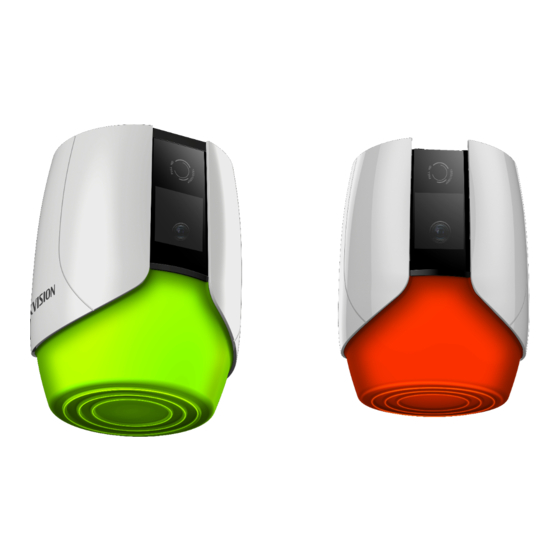
Table of Contents
Advertisement
Quick Links
Advertisement
Table of Contents

Summarization of Contents
Regulatory Information
FCC Information
Details FCC compliance and conditions for the device.
EU Conformity Statement
Explains CE marking, RoHS, and WEEE directives compliance.
Industry Canada ICES-003 Compliance
States compliance with Canadian ICES-003 standards.
Symbol Conventions
Symbol Definitions
Defines symbols like NOTE, WARNING, and DANGER used in the manual.
Safety Instructions
General Safety Precautions
Advises on power adapter usage, service, avoiding rain/moisture, and battery safety.
Preventive and Cautionary Tips
Handling and Usage Guidelines
Provides tips on avoiding physical shock, cleaning, aiming lens, temperature limits, and ventilation.
Chapter 1 OVERVIEW
1.1 Product Introduction
Introduces the parking camera series, its purpose, and applicable models.
1.2 Features and Functions
Lists key features like HD resolution, VCA, iBeacon, and network capabilities.
1.3 Appearance and Structure
Illustrates the physical design and components of the parking camera.
Chapter 2 INSTALLATION
Installation Steps
Details the procedure for mounting the parking camera on a bridge.
Chapter 3 SYSTEM REQUIREMENT
Hardware and Software Requirements
Lists the necessary operating system, CPU, RAM, display, and browser specifications.
Chapter 4 NETWORK CONNECTION
4.1 Setting the Parking Camera over the LAN
Guides on connecting and configuring the camera within a Local Area Network.
4.2 Setting the Parking Camera over the WAN
Explains how to connect and configure the camera for Wide Area Network access.
Chapter 5 ACCESSING TO THE PARKING CAMERA
5.1 Accessing by Web Browsers
Instructions for accessing the camera interface via a web browser, including plug-in installation.
5.2 Accessing by Client Software
Details on using the iVMS-4200 client software for camera management.
Chapter 6 CONFIGURING WI-FI SETTINGS
6.1 Configuring Wi-Fi Connection in Manage and Ad-hoc Modes
Guides Wi-Fi setup for infrastructure and ad-hoc network modes.
6.2 Easy Wi-Fi Connection with WPS function
Explains WPS for simplified Wi-Fi connection using PBC or PIN modes.
6.3 IP Property Settings for Wireless Network Connection
Covers configuring IP settings for the wireless network interface.
Chapter 7 CONFIGURING BLUETOOTH
Bluetooth Configuration Parameters
Details how to configure Bluetooth settings like broadcast interval and power.
Chapter 8 LIVE VIEW
Live View Interface and Controls
Explains the live view page, icons, and basic operations like capturing images and adjusting streams.
Chapter 9 CONFIGURING PARKING CAMERA
9.1 Configuring Local Parameters
Sets up local recording, snapshot paths, and image formats.
9.2 Configuring Time Settings
Manages time synchronization using NTP or manual settings, including DST.
9.3 Configuring Network Settings
Configures TCP/IP, port, PPPoE, DDNS, SNMP, 802.1X, QoS, and UPnP settings.
9.4 Configuring Video and Audio Settings
Adjusts video stream types, resolution, bitrate, encoding, and ROI.
9.5 Configuring Image Parameters
Manages display settings, OSD, text overlay, and privacy mask for image quality.
9.6 Configuring and Handling Alarms
Sets up motion detection and exception handling for alarm events.
Chapter 10 CONFIGURING PARKING SPACE DETECTION
10.1 Configuring Detection Rules
Enables VCA function and configures parameters for license plate and vehicle recognition.
10.2 Configuring Parking Space Indicator
Sets up indicators for displaying parking space status (occupied, unoccupied).
10.3 Uploading Pictures
Configures uploading captured parking space images to remote hosts or FTP.
10.4 Checking Parking Space Status
Describes how to view the current status of parking spaces.
10.5 Typical Applications
Illustrates common usage scenarios for parking space indicators.
Chapter 11 CONFIGURING STORAGE SETTINGS
11.1 Configuring NAS Settings
Sets up Network-Attached Storage for recording files and logs.
11.2 Configuring Recording Schedule
Defines schedules for manual and continuous video recording.
Chapter 12 PLAYBACK
Playback Interface and Controls
Explains how to access and use the interface for viewing recorded video files.
Chapter 13 SEARCHING LOG
Log Searching and Exporting
Details how to search, filter, and export camera operation and alarm logs.
Chapter 14 OTHERS
14.1 Managing User Accounts
Covers adding, modifying, and deleting user accounts with permission settings.
14.2 Configuring RTSP Authentication
Secures live stream data by configuring RTSP authentication.
14.3 Configuring Anonymous Visit
Enables or disables anonymous access for live view without credentials.
14.4 Filtering IP Address
Implements access control by allowing or forbidding specific IP addresses.
14.5 Viewing Device Information
Displays hardware and firmware details of the parking camera.
14.6 Maintenance
Provides functions for rebooting, restoring defaults, and managing configuration files.
14.7 Configuring RS-485 Settings
Configures parameters for controlling PTZ devices via the RS-485 serial port.
14.8 Configuring Service Settings
Enables IR light and configures illegal login lock settings.
Appendix 1 SADP Software Introduction
SADP Software Description
Introduces SADP tool for searching and managing network devices.
Searching Online Devices
Explains how to automatically and manually search for active devices using SADP.
Modifying Network Parameters
Details how to adjust IP address, port, and other network settings via SADP.
Restoring Default Password
Outlines the process for resetting the device's default password.
Appendix 2 Port Mapping
Router Port Mapping Configuration
Guides on setting up port forwarding on a TP-LINK router for camera access.















Need help?
Do you have a question about the DS-TCP345 and is the answer not in the manual?
Questions and answers